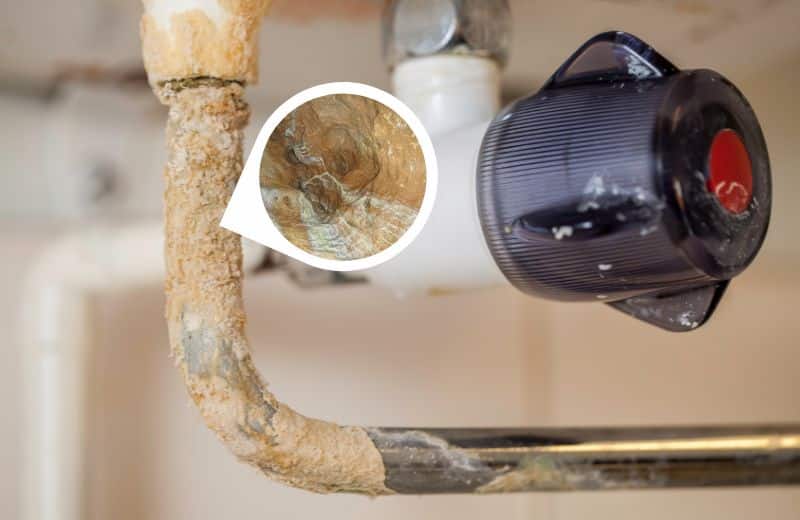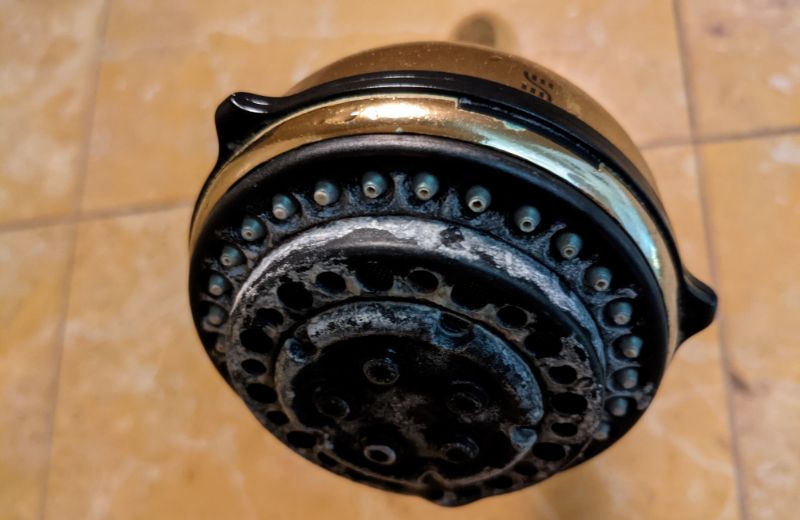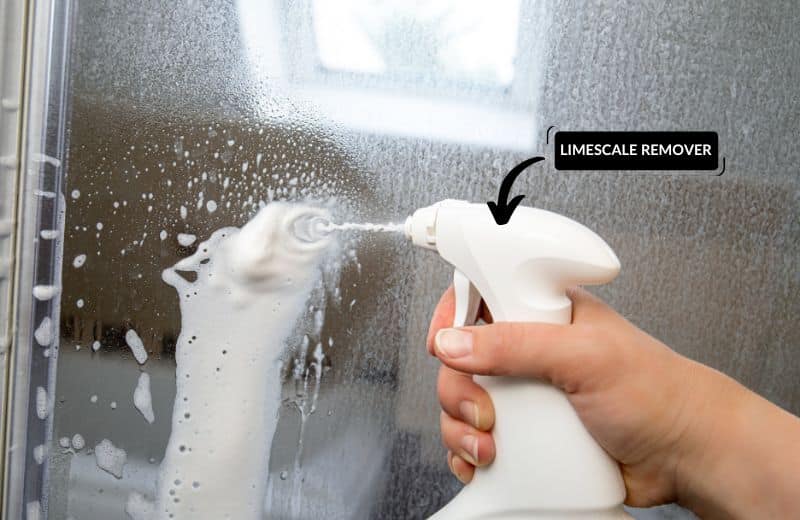Limescale is a nightmare side-effect of hard water, causing hundreds of dollars worth of damage – but some people aren’t even aware that they have it in their homes.
So what is limescale, and what makes limescale bad?
Limescale is the white, chalky deposits you might notice in areas that water touches, such as around the base of your faucets, on your showerhead, and in your coffeepot.
Limescale deposits are difficult to clean and build up in your plumbing system over time, reducing water flow and affecting the efficiency of your appliances.
In this guide, we’ll be looking at the dangers of limescale, how to know if you have limescale in your home, quick fixes for cleaning limescale, and – most importantly – how to eliminate limescale entirely from your water supply.
Table of Contents
🔎 Signs of Limescale in your Home
You won’t have to look too hard to find limescale in your home. Most people are familiar with the appearance of limescale, even if they don’t know what it is.
Limescale is yellowy-white in color, and rough, crusty, or chalky in texture. The most common places you’ll find limescale are those that come into regular contact with water, like:
- Your sinks and faucets
- Your showerheads and shower screens
- Your coffee pots
- Water pitchers, pet bowls, and storage containers
- Your toilet bowl
Seeing physical marks in your kitchen and bathroom is the most obvious sign that you have limescale. But there are other, less obvious signs to look out for that indicate limescale is present in your plumbing and appliances:
- Reduced water flow in your home, due to limescale buildup in your pipes
- Appliances dying an early death, due to limescale buildup in their components
A strong mineral taste in your water is also a sign that you likely have limescale in your home.
Related: How to remove limescale from inside pipes

📰 What Causes Limescale Deposits?
Limescale deposits occur when hard water comes into contact with solid surfaces.
Hard water is water with a high concentration of calcium and magnesium minerals, known as hardness minerals.
Around 85% of homes in the US have hard water, so it’s far from a rare occurrence. Unless you’re lucky, it’s highly unlikely that your home’s water is naturally soft.
Hard water isn’t dangerous to health – in fact, calcium and magnesium are healthy minerals that we need to survive – but it’s incredibly damaging to our plumbing systems.
When hard water touches surfaces, the insoluble calcium carbonate and magnesium deposit onto the surfaces. Over time, these deposits become noticeable, and build up in layers, becoming thicker and thicker.
Limescale loves hot water, so the higher the water temperature in your home, the more limescale you’ll find. For instance, limescale will accumulate quickly around your hot water faucets.
🚱 What’s so Bad about Limescale?
You’ve probably caught on by now that limescale isn’t a desirable feature of your home.
Some of the biggest problems associated with limescale build-up are listed below:
Ugly Stains
If you’re house-proud, you’ll hate the stains associated with limescale build-up.
Limescale makes your home look dirty, like you don’t clean it as often as you should. It’s most common in toilets, sinks, and showerheads, giving your bathroom an ugly, old appearance.
We all love the gleam and sparkle of polished chrome, but this is nearly impossible to achieve when you have limescale.
Increased Cleaning Duties
Limescale isn’t only ugly – it’s also near-impossible to remove.
Once a layer of limescale has formed on your surfaces, it becomes an Olympic event to get rid of it. Standard cleaners won’t do the job, and most people resort to using high-acidity cleaners or bleach to scrub the stains away.
If your home is plagued with limescale, cleaning will be harder and harsher – you’ll have no choice but to use irritating chemical cleaning supplies in your fight against scale.
Damaged Appliances
Even if it takes a whole lot of effort, at least you can remove limescale in plain sight. The limescale that you can’t see is more dangerous, especially when it builds up inside your appliances.
Even a tiny layer of limescale can increase an appliance’s energy consumption by 29%. Because of the reduced water flow caused by limescale stains, appliances must work harder than usual to overcome the setbacks that they’re not designed to function with. The result? Appliances are quick to break, develop faults, or pack in entirely.
Faulty Faucets and Shower Heads
Two of the worst bathroom surfaces to find scale are your shower head and your faucets. For a start, removing limescale from the tiny crevices of your shower head is near-impossible. For second, failing to remove limescale from these locations prevents the appliances from working properly.
When left to its own devices, limescale eventually clogs faucets and shower heads, preventing water from escaping. If only half your shower head emits water, it’s probably because the other half is clogged with limescale.
Glass surfaces like shower screens can also be damaged by magnesium and calcium carbonate ions.

Bad Hair and Skin
Limescale forms on all surfaces, and your skin and hair are no exception.
Soluble calcium bicarbonate and magnesium ions collect on the surface of your skin and in your hair when you shower. These minerals have a stickiness that you can often feel if you touch your skin or hair after you’ve washed.
Dryness, irritated skin, and split ends are common effects of showering in hard water.
The fatty acids in soaps and shampoos react with the magnesium and calcium ions responsible for scale, forming chemicals that coagulate. Resultantly, we end up with a residue on our hair and skin – called soap scum – which can disrupt the skin barrier and prevent moisture from entering hair strands.
If you’ve been having one too many bad hair days recently, limescale could be to blame.
Related: Is limescale bad for you?
Lose Money
Whatever limescale damage you find in your home, the consequences all come back to this: money loss.
Nobody likes the idea of spending more money than they need to spend, especially when it’s on boring stuff like bills. With limescale, your water flow will reduce, and your appliances will need to work harder to do the same job. As a result, your energy bills will skyrocket.
For instance, it costs around 30% more to run a hot water heater with water containing limescale. Harmful hardness minerals cause more and more damage to your heater’s heating elements, increasing the costs associated with using water in your home.
📝 How to Know if you have Limescale
We’ve already covered the signs of limescale – but how do you know for sure that you’re dealing with hard water?
Our advice is to test your water. Buy a water testing kit online (they cost less than $10) and follow the instructions to get a water hardness reading.
If your water contains 61 to 120 mg/L of calcium carbonate, it’s moderately hard – and that’s enough for limescale to form. Anything higher than this, and your water is classed as hard or very hard, meaning you have the most damaging effects of limescale in your home.
| Hardness | Grains per Gallon (GPG) | Parts per Million (PPM) & mg/L |
|---|---|---|
| Soft | <1 | 0 – 17 |
| Slightly Hard | 1 – 3.5 | 17 – 60 |
| Moderately Hard | 3.5 – 7 | 60 – 120 |
| Hard | 7 – 10 | 120 – 180 |
| Very Hard | >10 | >180 |
🥷 How to Remove Limescale Quickly: Cleaning Hacks
Are there any quick fixes for limescale removal? Not really.
Still, we’ve found a few cleaning hacks that worked for us before we said “f&!k it” and bought a water softener (more on that later).
If you don’t want to gas your home with dangerous chemicals, you’ll be pleased to know that we’ve focused on natural remedies using household essentials that you probably already have in your cupboards.
Below, you’ll find the proven most effective ways to remove limescale in different parts of your home. Don’t forget to wear gloves!
Kitchen and Bathroom Faucets
You’ll need:
Add the white vinegar to a container and dip the soft cloth in the vinegar solution. Use an elastic band to tie the cloth around your affected faucet(s). After 1 hour, remove the cloth and gently rub the faucet with a clean cloth to remove the leftover limescale.
Toilets
You’ll need:
To remove the dirty limescale ring in your toilet, add four cups of white vinegar to the bowl. Leave the vinegar to sit overnight, then scrub the toilet the next morning with a brush. If the stains are really bad, use pumice or sandpaper to get rid of all the residue.
Showerheads
You’ll need:
Halve a lemon and rub each half onto your showerhead, making sure the lemon juice gets into all the inner surfaces of the appliance. Leave for 30 minutes to allow the citric acid in the lemon juice to lift the limescale. Scrub the surface using an unused toothbrush until you’ve removed all the limescale, then rinse with water.
Shower Screens
You’ll need:
Combine two tablespoons of dish soap with one cup of vinegar and half a cup of water. Add the solution to a bottle and spray it onto your shower screens and other glass surfaces. Use a scrubbing sponge to scrub the limescale away.

Stovetop Kettles & Coffee Pots
You’ll need:
Add one cup of water and two cups of vinegar to the inside of your kettle. Boil the mixture in the kettle, then pour the boiling water away and rinse the inside of the kettle with clean, soft water. Repeat the process once more for bad staining.
Small Areas of Limescale
You’ll need:
For small limescale stains on your tiles or in your sinks, combine equal parts vinegar (or lemon juice) and warm water in a spray bottle, then spray surfaces and leave the solution for five minutes. Use a cloth to clean away the limescale.
For stubborn areas, sprinkle baking soda onto the vinegar before leaving for five minutes.
✅ How to Eliminate Limescale for Good
You probably already know that our no cleaning hack, no matter how effective, can’t keep limescale away forever.
Even if you managed to clean the limescale completely from your surfaces, you can’t use cleaning alone to prevent limescale from returning.
To avoid all issues with limescale for the indefinite future, you need a life-changing invention called a water softener.
The job of a water softening system is to prevent limescale from forming anywhere in your home by removing hardness mineral ions from your water supply. Water softeners are installed at your home’s point of entry, before your hot water heater, meaning that all your appliances – from washing machines to toilets, coffee makers to showers – are protected.
👉 See our top picks and water softener reviews for 2025 here.

How do water softeners work?
Traditional salt-based systems use a process called ion exchange to replace all the minerals that cause limescale with sodium, or salt.
Don’t panic – only a tiny amount of salt is added to your water. You won’t taste it.
As a result, the soft water flowing through your home contains no hardness minerals, so it’s no longer possible for scale build-up in your pipes or appliances.
Water softeners are one of the best – if not the best – preventative measures for limescale. Why bother trying to remove limescale temporarily when you could get rid of it for good?
If you’re keen to learn more about water softeners and how soft water can prevent major problems associated with limescale, we’ve answered all your questions in our massive water softener guide.
